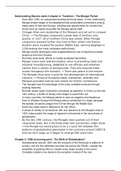Samenvatting
Samenvatting Globalization in World History: Chapter 4, gedeelte van 5
- Vak
- Globalisering I
- Instelling
- Rijksuniversiteit Groningen (RuG)
Samenvatting van het boek: Globalization in World History, van Peter Stearns. Hoofdstuk 4 helemaal, 5 gedeeltelijk.
[Meer zien]







